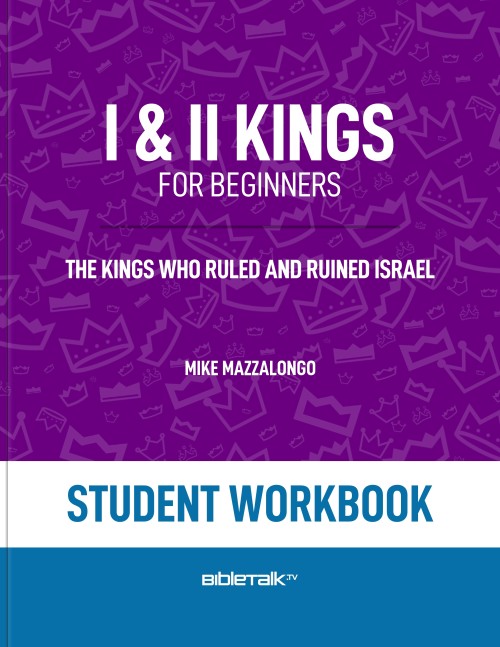Solomon's Glory and Fall
The books of I and II Samuel chronicle the transition of Israel from a loose confederation of tribes to a unified kingdom under a central monarchy. These books detail the rise and fall of key figures like the prophet Samuel, King Saul, and King David, highlighting themes of leadership, covenant, and divine intervention.
Samuel serves as the last judge and the anointer of kings, while Saul's tragic reign and David's complex legacy shape Israel's early monarchy. As II Samuel closes with the reign of David, we see both his triumphs and personal failures, setting the stage for the next generation of rulers.
This natural progression leads us into I and II Kings, where the focus shifts to the reign of David's successors.
Background
The books of I and II Kings continue the historical narrative of Israel's monarchy, beginning with the reign of Solomon and tracing the division of the kingdom into Israel (the northern kingdom) and Judah (the southern kingdom).
They culminate in the fall of both kingdoms, with Israel conquered by Assyria in 722 BC and Judah by Babylon in 586 BC. Traditionally, the authorship is attributed to a prophet or group of prophets, though some scholars suggest it may have been compiled by editors during the Babylonian exile.
Key theological themes include the covenant faithfulness of God, the consequences of idolatry and disobedience, the role of prophets in calling kings and people to repentance, and the sovereignty of God over history.
These themes underscore the central message that Israel's fate is directly tied to their relationship with God and their adherence to His covenant. As we study these books, we witness the moral and spiritual decline of the nation and God's judgment, yet also see His enduring mercy and commitment to His promises.
I. Solomon's Rise to Power - I Kings 1-3
1. Adonijah's Attempt to Seize the Throne (I Kings 1:1-10)
As King David grew old and weak, his son Adonijah declared himself king without David's approval. He gathered support from key figures like Joab, the commander of the army, and Abiathar the priest, and held a banquet to celebrate his self-proclaimed kingship.
2. Nathan and Bathsheba's Intervention (I Kings 1:11-27)
Nathan the prophet, aware of Adonijah's plot, approached Bathsheba, Solomon's mother, urging her to remind David of his promise that Solomon would succeed him as king. Together, they informed David of Adonijah's actions and asked him to publicly affirm Solomon's right to the throne.
3. David's Public Declaration of Solomon as King (I Kings 1:28-40)
Upon hearing the news, David immediately ordered that Solomon be anointed king. Zadok the priest, Nathan the prophet, and Benaiah led Solomon to be anointed at Gihon. Solomon was then declared king, and the people rejoiced greatly, causing a loud celebration throughout Jerusalem.
4. Adonijah Submits to Solomon (I Kings 1:41-53)
Hearing the news of Solomon's anointing, Adonijah and his supporters became fearful. Adonijah sought refuge by grasping the horns of the altar. Solomon, showing mercy, allowed Adonijah to live on the condition that he prove himself loyal.
5. David's Final Instructions to Solomon (I Kings 2:1-12)
Before his death, David gave Solomon instructions regarding how to lead the kingdom faithfully according to God's law. He also advised Solomon on matters of justice, particularly concerning Joab, Shimei, and others who had wronged David. After David's death, Solomon's reign began, and his kingdom was firmly established.
6. Solomon Consolidates His Rule (I Kings 2:13-46)
Solomon solidified his reign by dealing with potential threats. He executed Adonijah after Adonijah requested to marry Abishag, David's former attendant—a move interpreted as a power play for the throne (2:13-25).
Solomon also removed Abiathar from the priesthood and ordered the execution of Joab for his past crimes (2:26-34). Finally, Solomon dealt with Shimei, who violated an oath, securing his control over the kingdom (2:36-46).
7. Solomon's Request for Wisdom (I Kings 3:1-15)
Solomon made an alliance with Pharaoh, king of Egypt, and married his daughter (3:1). Shortly after, Solomon traveled to Gibeon to offer sacrifices. While there, God appeared to him in a dream and offered to grant him any request. Solomon humbly asked for wisdom to govern the people. Pleased with Solomon's request, God granted him wisdom, wealth, and honor, promising him a long life if he followed God's commands.
8. Solomon's Wisdom Displayed (I Kings 3:16-28)
Solomon's wisdom became evident in the famous case of two women who claimed to be the mother of the same child. Solomon proposed to divide the living child in two, revealing the true mother by her willingness to give up the child to save its life. This judgment demonstrated Solomon's God-given wisdom, causing the people of Israel to revere him.
- Question: Why would asking to have Abishag as wife be interpreted as a power grab for the throne?
- Answer: In the cultural context of ancient Israel, asking for the hand of a former king's concubine or attendant was seen as more than just a personal request – it carried political implications. Concubines were often considered part of the royal household, and having access to them could symbolize a claim to the king's power and authority.
In the case of Abishag, who had been David's attendant, Adonijah's request to marry her (I Kings 2:13-25) could be interpreted as an attempt to strengthen his claim to the throne, especially since he had previously attempted to declare himself king. By seeking to marry someone so closely associated with David, Adonijah could have been perceived as trying to position himself as David's successor, indirectly challenging Solomon's legitimate rule.
Solomon, recognizing this political maneuver, saw it as a renewed attempt by Adonijah to undermine his reign and therefore responded by ordering his execution, solidifying his authority as king.
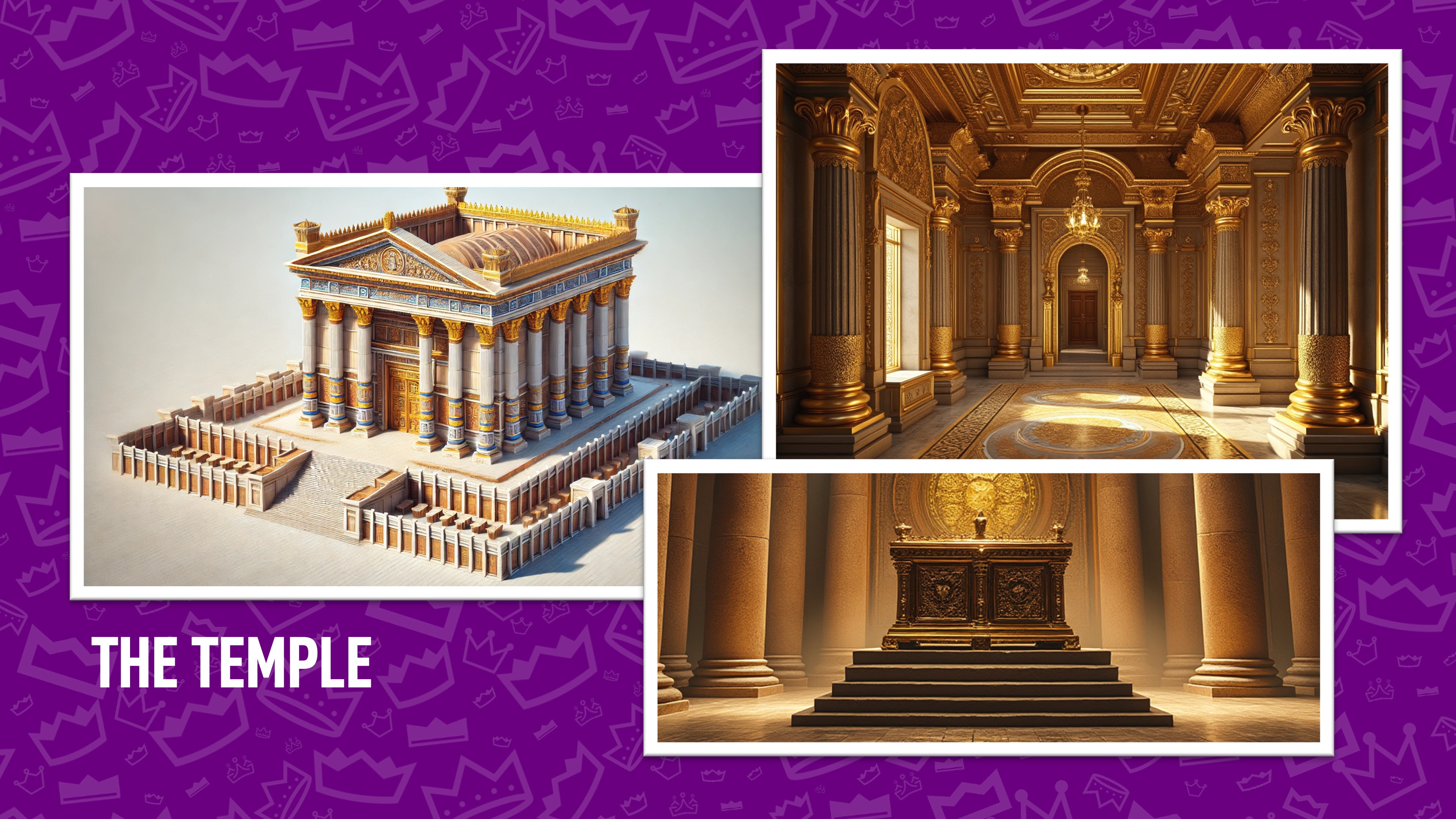
II. Solomon Builds and Dedicates the Temple - I Kings 4-8
Chapter 4: Solomon's Leadership and Wisdom
This chapter lays the groundwork for Solomon's successful reign. Solomon, renowned for his wisdom, organizes his kingdom efficiently.
Administrative Structure
Solomon appoints officials to manage various regions of Israel and oversee government functions, ensuring stability and prosperity.
Prosperity and Peace
Israel enjoys a time of peace and abundance under Solomon. His wisdom is recognized by nations far and wide, and his reign is marked by prosperity for his people.
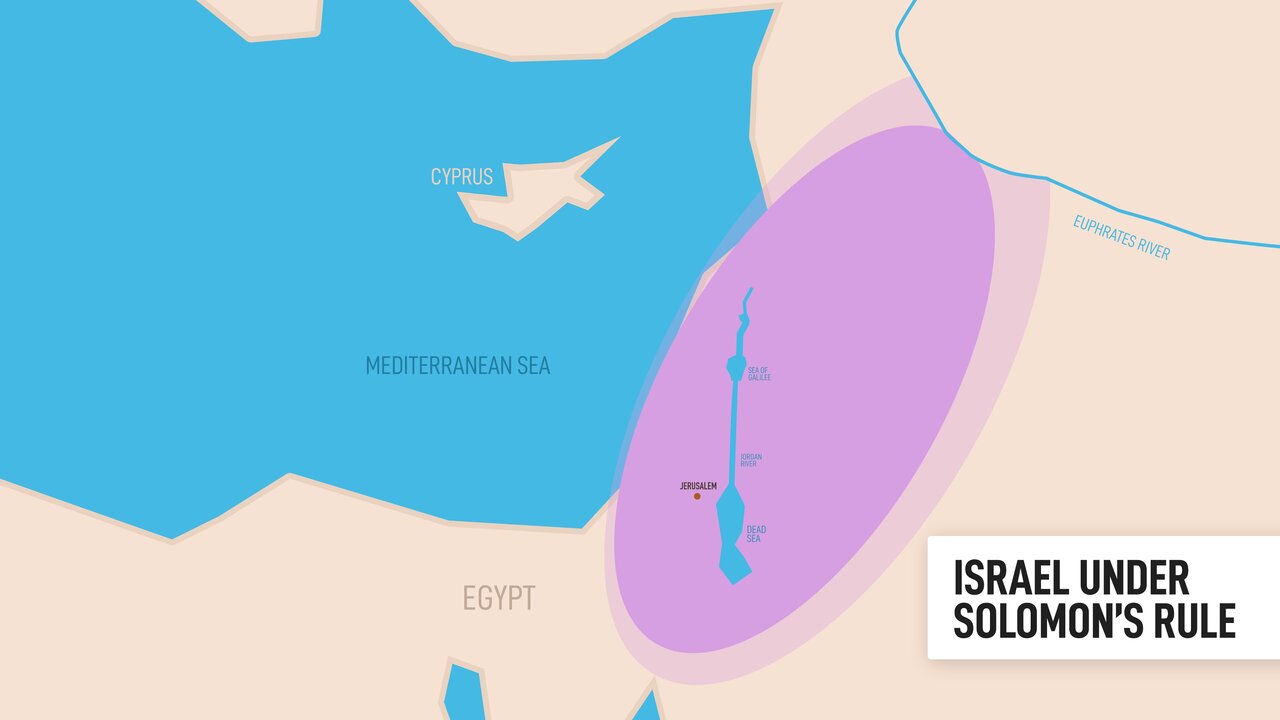
The Extent of Solomon's Kingdom
Israel's borders are vast, and Solomon rules over many nations that bring him tribute, allowing Israel to flourish.
Chapter 5: Preparations for the Temple
This chapter details Solomon's preparations to build the Temple, a central project of his reign.
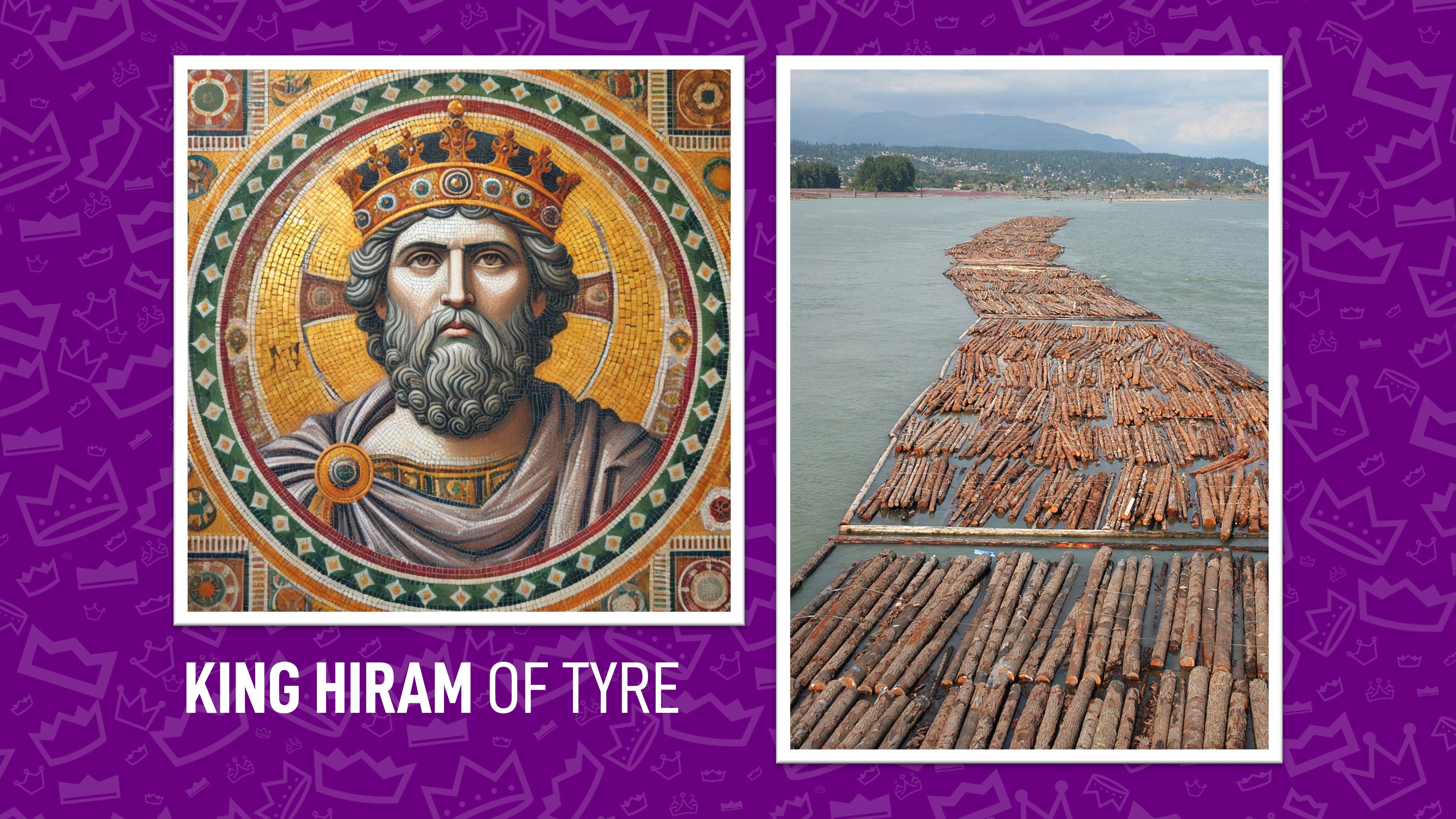
Alliance with Hiram of Tyre
Solomon forms an alliance with Hiram, king of Tyre, to supply cedar and cypress wood from Lebanon. Hiram's skilled craftsmen also contribute to the building project.
Labor Force for the Temple
Solomon conscripts a large workforce, including Israelites and foreigners living in the land, to carry out the construction. This labor force is responsible for quarrying stone, transporting materials, and constructing the Temple.
Chapter 6: Construction of the Temple
In this chapter, the building of the Temple begins in earnest, following specific instructions regarding its dimensions and design.
The Temple's Structure
The Temple is built according to precise measurements. It is 60 cubits long, 20 cubits wide, and 30 cubits high. The inner sanctuary, also called the Most Holy Place, is where the Ark of the Covenant would be placed.
Design and Decorations
The Temple is adorned with elaborate carvings of cherubim, palm trees, and open flowers. The walls are overlaid with gold, giving the Temple a majestic appearance.
Seven-Year Construction
It takes seven years to complete the construction of the Temple, a symbol of Israel's devotion to God.
Chapter 7: Additional Buildings and Furnishings
Solomon's building projects extend beyond the Temple to include his royal palace and various other important structures.

Solomon's Palace
Solomon also constructs a royal palace complex, which takes 13 years to complete. This includes the Hall of Justice and a special house for Pharaoh's daughter, his wife.
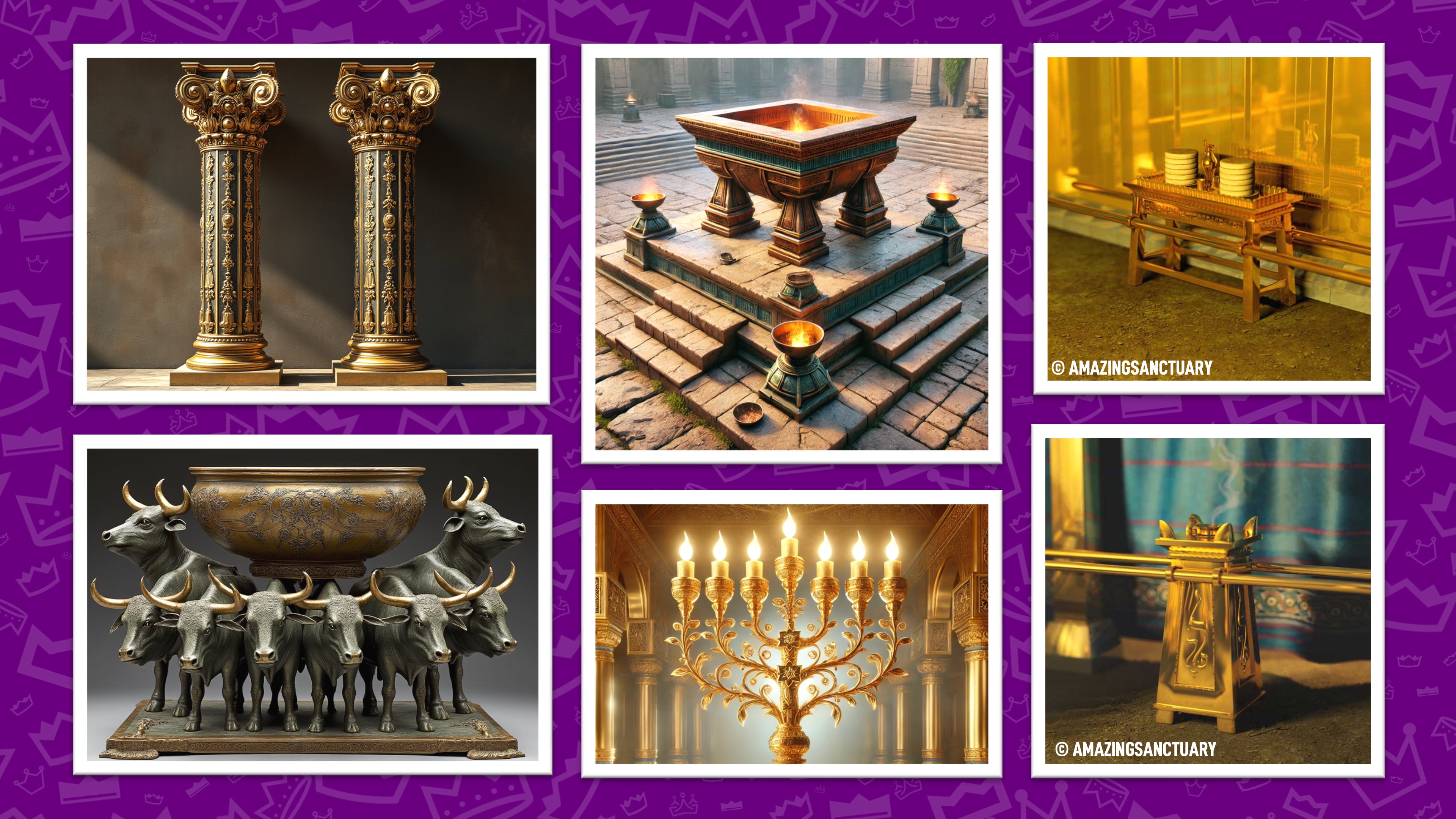
Temple Furnishings
The chapter details the craftsmanship of Hiram from Tyre, who creates many of the Temple's furnishings, including the two bronze pillars named Jachin and Boaz, the bronze Sea (a large basin for ritual washing), and various other utensils used for worship.
Symbolism and Craftsmanship
The detailed description of the craftsmanship shows the immense care and skill involved in creating objects for worship, emphasizing the sacredness of the Temple.
Chapter 8: Dedication of the Temple
The climax of Solomon's efforts is the dedication of the Temple, a grand ceremony that marks the fulfillment of God's promise.
Bringing the Ark to the Temple
Solomon gathers all the leaders of Israel to bring the Ark of the Covenant from the city of David to the Temple. The Ark is placed in the Most Holy Place, beneath the wings of the cherubim.
The Glory of the Lord Fills the Temple
As the priests leave the holy place, a cloud fills the Temple, signifying the presence of God. Solomon recognizes this as the fulfillment of God's promise to dwell among His people.
Solomon's Prayer of Dedication
Solomon prays a heartfelt prayer, acknowledging God's faithfulness to Israel. He asks for God's continued presence and protection, praying that the Temple would be a place where the people can seek forgiveness, mercy, and justice.
Sacrifices and Feasting
Solomon offers sacrifices, and a grand feast is held for all Israel. The dedication ceremony lasts for fourteen days, marking a significant moment in Israel's history as the Temple becomes the center of worship for the nation.
- Question: Did they actually sacrifice the thousands of animals recorded at the dedication of the Temple or was there a method of substitution. Is there any information as to how this was carried out given the time and manpower available?
- Answer: The account of Solomon's dedication of the Temple in I Kings 8:62-63 records a massive number of animal sacrifices: 22,000 cattle and 120,000 sheep and goats. This raises understandable questions about how such a vast number of sacrifices could be practically carried out in terms of time, manpower, and ritual requirements.
Here are some points that provide context and possible explanations for how this might have been managed:
1. Duration of the Celebration
The dedication ceremony lasted for 14 days (I Kings 8:65). Spreading the sacrifices over this extended period of time would make it more feasible to manage such a large number of offerings. This would mean that not all the animals were sacrificed on a single day, but rather across the two weeks of the festival.
2. Multiple Altars and Priests
While the Temple had a main altar for sacrifices, it is possible that additional altars were temporarily set up to accommodate the large volume of sacrifices. Also, there was a large number of priests involved in the rituals. According to II Chronicles 5:11, all the priests present sanctified themselves for this event, indicating a larger-than-usual priestly workforce.
Given that Israel had 24 divisions of priests, many of whom would have been on duty for such a major national event, this would have greatly increased the manpower available to carry out the sacrifices.
II Chronicles 7:7 adds that Solomon "consecrated the middle part of the courtyard" to offer additional sacrifices because the bronze altar was too small to handle all the burnt offerings, grain offerings, and fat of the fellowship offerings. This suggests that alternative arrangements were made to handle the sheer volume.
3. Types of Offerings and Division of Labor
Not all the animals would have been sacrificed in the same way. Different kinds of offerings (e.g., burnt offerings, fellowship offerings, sin offerings) had different ritual procedures. For example:
- Burnt Offerings: The entire animal would be consumed by fire.
- Fellowship/Peace Offerings: Only certain parts of the animal (the fat and internal organs) were burned on the altar, while the rest was eaten by the priests and people (Leviticus 3). The fellowship offerings, especially, involved the community in feasting, which would have allowed for more people to participate and reduce the workload on the priests.
4. Symbolic Numbers
In the ancient Near East, large numbers in ceremonial contexts were sometimes used symbolically. While the numbers recorded in I Kings 8 may reflect the actual scale of the event, they might also emphasize the grandeur and significance of the dedication rather than be strictly literal. This was a monumental event, and hyperbolic numbers were often employed in ancient texts to convey importance.
5. Method of Sacrificing
The sacrifices themselves could have been carried out efficiently through the division of labor. The priests and Levites would have been well-practiced in performing the necessary rituals. Given the scale of the event and the potential additional altars, the process would have been highly organized, with different groups handling specific tasks (e.g., slaughtering, preparation, and burning).
6. Communal Feasting
The sacrificed animals were not wasted. The meat from fellowship and peace offerings would have been shared among the people, providing food for the thousands of Israelites who attended the ceremony. This communal feasting was a central part of Israelite worship, especially at such significant events. The large number of sacrifices would have provided food for a vast number of participants over the two-week period.
Conclusion
While the exact logistics of how such a large number of sacrifices were carried out isn't detailed, the extended time frame, the use of multiple altars, the involvement of many priests, and the community's participation in the feasting make the account more plausible. Scholars estimate an attendance of 100,00 - 300,000 people.
III. Solomon's Wealth and Downfall - I Kings 9-11
Chapter 9: God's Second Appearance to Solomon and His Building Projects
After completing the Temple and his palace, Solomon receives a second appearance from the Lord, who reiterates both His promise and warning.
God's Covenant with Solomon
God reaffirms the covenant, promising to bless Solomon and his descendants if they remain faithful and walk in His ways. However, God also warns Solomon that if he or his people turn to idolatry, Israel will be cut off, and the Temple will be destroyed (I Kings 9:4-9).
Solomon's Building Projects
Solomon continues his massive building campaign. He fortifies cities, builds a fleet of ships, and enhances the infrastructure of his kingdom.
Alliance with Hiram of Tyre
Solomon continues his alliance with Hiram, supplying him with cities in Galilee in exchange for building materials. Hiram's dissatisfaction with these cities hints at growing strains in foreign relations (I Kings 9:10-14).
Chapter 10: Solomon's Wealth and Fame
Chapter 10 highlights Solomon's extraordinary wealth, his international fame, and his relationships with foreign powers, but also sets the stage for his eventual downfall.
The Visit of the Queen of Sheba
The Queen of Sheba visits Solomon, attracted by his wisdom and the prosperity of his kingdom. She brings gifts of gold, spices, and precious stones, further enhancing his reputation. After testing Solomon's wisdom and seeing the wealth of his court, she praises God and Solomon for the prosperity of Israel (I Kings 10:1-13).
Solomon's Wealth
The chapter details Solomon's incredible wealth, including his vast income from trade, tribute from other nations, and his impressive collection of gold, ivory, and luxurious goods.
- Solomon acquires 666 talents of gold annually, a symbol of his wealth and power. That would be 1 Billion, 350 million dollars in today's gold prices.
- He constructs a magnificent throne of ivory overlaid with gold and surrounds himself with shields of gold (I Kings 10:14-22).
- He imports horses and chariots from Egypt, establishing a powerful military force.
Foreign Alliances
Solomon establishes alliances with various foreign nations, including Egypt, through marriage to Pharaoh's daughter, and builds a vast network of influence. These alliances lead to the influx of foreign religious practices into Israel.
Chapter 11: Solomon's Idolatry and Downfall
Solomon's wealth, marriages, and alliances with foreign powers ultimately lead to his spiritual and political decline.
Solomon's Many Wives
Solomon marries 700 wives and has 300 concubines, many of whom are from foreign nations. These marriages were likely politically motivated, aimed at securing alliances with surrounding nations. However, they become a source of great spiritual danger (I Kings 11:1-3).
Idolatry and Turning Away from God
As Solomon grows older, his foreign wives turn his heart away from the Lord. He begins to worship and build high places for foreign gods like Ashtoreth, Molech, and Chemosh, gods of the Moabites, Ammonites, and Sidonians. His idolatry leads to Israel's spiritual decline (I Kings 11:4-8).
God's Judgment
God becomes angry with Solomon for breaking His covenant and commands, especially after God had appeared to him twice. As punishment, God declares that the kingdom will be torn from Solomon's descendants, though not during Solomon's lifetime for the sake of David. Instead, the kingdom will be divided after Solomon's death, with only a portion remaining under his son's control (I Kings 11:9-13).
The Rise of Adversaries and Solomon's Decline
As Solomon's reign progresses, God raises up adversaries to challenge his rule, foreshadowing the instability that will follow his death.
Hadad the Edomite: A royal from Edom who had fled to Egypt during David's reign returns to become an enemy of Solomon, stirring rebellion against Israel (I Kings 11:14-22).
- Rezon of Zobah: Rezon, a leader from Zobah, establishes himself in Damascus and becomes another adversary, continually harassing Israel (I Kings 11:23-25).
- Jeroboam's Rebellion: Jeroboam, one of Solomon's officials, rebels against Solomon after a prophecy from the prophet Ahijah. Ahijah prophesies that Jeroboam will rule over ten tribes of Israel after the kingdom is divided (I Kings 11:26-40). Solomon attempts to kill Jeroboam, but Jeroboam flees to Egypt, where he remains until Solomon's death.
Solomon's Death
- End of Solomon's Reign: Solomon's reign, which began in wisdom and prosperity, ends in decline due to his disobedience and idolatry.
- Death and Succession: After ruling for 40 years, Solomon dies and is buried in the city of David, his father. His son Rehoboam succeeds him, inheriting a kingdom that is on the verge of division and turmoil (I Kings 11:41-43).
IV. Strengths and Weaknesses - Saul, David, Solomon
When comparing the reigns of Saul, David, and Solomon, each king had notable strengths and weaknesses that shaped the course of Israel's history. The following is a comparison highlighting one key strength and one significant weakness for each king.
Saul
Strength: Military Leadership and Uniting Israel – Saul's primary strength lay in his role as a military leader. He successfully defended Israel from external threats, particularly from the Philistines, and was able to unite the tribes of Israel under a central leadership for the first time (I Samuel 11:1-15). His military victories earned him respect and helped stabilize Israel during a time of external threats.
Weakness: Disobedience to God – Saul's greatest weakness was his inability to consistently obey God's commands. His two significant acts of disobedience—offering a sacrifice without waiting for Samuel (I Samuel 13:8-14) and sparing the Amalekite king and livestock against God's command (I Samuel 15:9-23)—led to God rejecting him as king. His failure to follow divine instruction resulted in the loss of his dynasty and the eventual decline of his reign.
David
Strength: Faith and Devotion to God – David's strength was his deep personal relationship with God. He is described as "a man after God's own heart" (I Samuel 13:14). Throughout his reign, David demonstrated a genuine faith and reliance on God, which led to significant military victories, including the defeat of Goliath, and the establishment of Jerusalem as the capital city of Israel (II Samuel 5:6-9). His devotion to God also led to the planning of the Temple, which his son Solomon would later build.
Weakness: Moral Failures and Family Discord – Despite his spiritual strength, David's personal moral failures, particularly his adultery with Bathsheba and the arranged death of her husband Uriah (II Samuel 11:1-27), marked a serious decline in his reign. This sin led to family discord, including the rebellion of his son Absalom (II Samuel 15-18). His family suffered from internal strife, and this undermined the stability of his kingdom.
Solomon
Strength: Wisdom and Prosperity – Solomon's reign was marked by his extraordinary wisdom, which he famously displayed when resolving disputes (I Kings 3:16-28). His wisdom led to the expansion of Israel's influence through trade, diplomacy, and alliances. Solomon's wealth and achievements, including the construction of the Temple (I Kings 6), brought prosperity and a golden age of peace and development to Israel.
Weakness: Idolatry and Spiritual Decline – Solomon's major weakness was his turning away from God due to the influence of his many foreign wives. His idolatry, as he built altars to foreign gods like Ashtoreth and Molech (I Kings 11:1-8), led to spiritual decline in Israel. His disobedience to God's laws concerning foreign marriages and worship ultimately led to God's judgment, the division of the kingdom, and the erosion of the political unity that had been achieved under his father David.
Comparison Summary
Strengths:
- Saul was a capable military leader who defended Israel from its enemies.
- David excelled in his faith and deep devotion to God, uniting the kingdom under God's guidance.
- Solomon was known for his wisdom, bringing prosperity and a golden age of peace to Israel.
Weaknesses:
- Saul's disobedience to God resulted in his rejection as king.
- David's moral failures caused family discord and internal instability.
- Solomon's idolatry led to spiritual decline and ultimately divided the kingdom.
Each king displayed a key strength that benefitted Israel but also had a critical weakness that shaped the trajectory of their reigns and the nation.
Sources
1. Biblical Text (Primary Source)
- Holy Bible: The main source for the content of I & II Kings is the Bible itself. The narrative of these chapters is found in various translations of the Bible such as:
- New International Version (NIV)
- English Standard Version (ESV)
- New King James Version (NKJV)
- King James Version (KJV)
2. Commentaries on I & II Kings
- Matthew Henry's Commentary on the Whole Bible: This classic work provides detailed analysis and insight into the historical and spiritual significance of the events in I & II Kings.
- John Gill's Exposition of the Bible: Another traditional commentary that offers verse-by-verse interpretation, helpful for understanding cultural and historical context.
- The New Interpreter's Bible Commentary: This modern series provides an in-depth look at the historical background and theological implications of I & II Kings.
3. Historical and Archaeological Context
- "Ancient Israel: Its Life and Institutions" by Roland de Vaux: This book gives detailed insights into the social, political, and religious aspects of Israelite life, providing valuable context for the narrative of I & II Kings.
- "The Archaeology of the Israelite Settlement" by Israel Finkelstein: Finkelstein's work on the archaeology of Israelite sites sheds light on the historical reality behind the biblical stories, particularly in the time of the monarchy.
4. Bible Dictionaries and Encyclopedias
- "The Anchor Yale Bible Dictionary": A comprehensive resource that provides background on key figures, events, and places mentioned in I & II Kings.
- "The International Standard Bible Encyclopedia" (ISBE): Offers extensive background information on the historical context, geography, and key themes of I & II Kings.
5. Journals and Scholarly Articles
- Journal of Biblical Literature (JBL): Contains scholarly articles on the historical and theological analysis of the books of Kings.
- Biblical Archaeology Review (BAR): Publishes archaeological findings that often pertain to the events and figures described in the books of Kings, including the reigns of Solomon and the divided monarchy.
6. Study Bibles
- The NIV Study Bible: Provides study notes, background information, and theological commentary on the text of I & II Kings.
- The ESV Study Bible: Contains detailed maps, notes, and timelines to help place the events of I & II Kings within their broader biblical and historical framework.
7. Theological and Historical Books
- "A Survey of Israel's History" by Leon J. Wood: This work gives an academic overview of Israel's monarchy, with a focus on the reigns of Saul, David, and Solomon, helping to understand the progression of I & II Kings.
- "Israelite Religions: An Archaeological and Biblical Survey" by Richard S. Hess: Offers a comprehensive look at the religious practices during the time of the Kings, helpful for understanding the spiritual issues in Solomon's reign.
These sources provide a blend of biblical, historical, archaeological, and theological insights that help contextualize and interpret the material in I & II Kings.



